Casio Keyboard 1990
Posted By admin On 08/04/22Customers who buy a USB MIDI keyboard can rely on the proven quality and features of a compact CASIO keyboard at all times. Exclusive materials, and depending on the model up to 76 touch-sensitive. Casio Electronic Devices Co., Ltd., was established in 1990 as an electronic device sales company. The company assessed potential OEM demand for devices such as the LCDs used in Casio products. Casio Electronic Devices Co., Ltd., was established in 1990 as an electronic device sales company. The company assessed potential OEM demand for devices such as the LCDs used in Casio products. In line with demand, it then promoted further technological development, and with increasing orders, ultimately secured greater cost competitiveness.
- Casiotone refers to a series of home electronic keyboards released by Casio Computer Co., Ltd. In the early 1980s. In 2019 the series was revived with the launch of three new keyboards. Casio claims that the Casiotone 201 (CT-201) was 'the first electronic keyboard.
- Great deals on Casio Vintage Pianos, Keyboards, Parts & Accessories. It's a great time to upgrade your home music studio gear with the largest selection at eBay.com. Fast & Free shipping on many items!
Casiotone refers to a series of home electronic keyboards released by Casio Computer Co., Ltd. in the early 1980s. In 2019 the series was revived with the launch of three new keyboards.[1] Casio claims that the Casiotone 201 (CT-201) was 'the first electronic keyboard with full-size keys that anyone could afford'.[2]
The first Casiotone keyboards used a sound synthesis technique known as vowel-consonant synthesis to approximate the sounds of other instruments (albeit not very accurately). Most Casiotone keyboards were small, with miniature keys designed for children's fingers, and were not intended for use by professional musicians; they usually contained a rhythm generator, with several user-selectable rhythm patterns, and often the means to automatically play accompaniments. While the name 'Casiotone' disappeared from Casio's new keyboard catalog when more accurate synthesis technologies became prevalent, their low cost and abundance made them fairly common fixtures in garage rock bands. Musicians and bands known to use Casiotone keyboards include: Alexis Taylor of Hot Chip, TG Miller of Black Camaro, Dan Deacon, Lettie, Maurizio Arcieri of Krisma, Kevin Parker of Tame Impala, Turnstyle, Trio, Ozma, Cobol Pongide and Hedluv, Chiara Lee of Father Murphy, Elena Lozovskaya.


Families[edit]
Old Casiotone keyboards came in three distinct families, separated by the method of synthesis.[citation needed]
- The famous VL-Tone VL-1 (1979) uses a method of sound synthesis based on the Walsh function.
- Keyboards such as the CT-202 (c. 1981) use vowel-Consonant synthesis. The later model of this family, the MT-65, is one of the more well known and sought after models, as it also contains auto-accompaniment drum beats and bass lines.
- Some other keyboards (such as the MT-35 and MT-45) use a combination of two different binary weighted numbers (1 and 64). The larger weight bit provides the fundamental, and the smaller weight bit provides the harmonic complexity.

The later, more professional range of keyboards, the CZ series (1984–1986), used phase distortion synthesis, which is mathematically almost identical to Yamaha's frequency modulation synthesis, although implemented slightly differently in order to avoid patent infringement.
After the release of famous Casio SK-1 in 1985, gradually PCM sample based tone generator became dominant in Casio keyboards line. After the 1990s, most Casio keyboards utilize PCM tone generator or its variants.
Some early 1980s models in the PT series of keyboards, such as the PT-30, PT-50, PT-80 and PT-82, were not marketed under the Casiotone name. The name was revived again later for models such as the PT-87 (which is basically the same as the PT-82) which was again sold as Casiotone.
ROM Packs[edit]

Some models sold from 1983 onwards included a cartridge bay to accept Casio ROM Packs which contained sheet music in a digital format. The keyboards could play the notes automatically, or (with the exception of the PT-50[3]) illuminate LEDs above each key to teach the user how to play the song. Most keyboards came with one ROM Pack as standard, but a large number of additional packs, covering a wide range of musical genres, were available to purchase separately.[4] The last ROM Pack model was the CT-840, which came out in 1990.
- ROM Pack models (excerpt)
Casio PT-80
Casiotone MT-820
Casio DH-800 Digital Horn
See also[edit]
References[edit]
- ^Casio Unveils Revamped Casiotone Series At Summer NAMM 2019[1]
- ^'Casiotone Series Casio Music Gear'. www.casiomusicgear.com. Retrieved 2019-11-27.
- ^Casio PT-50 Unlike the later ROM Pack keyboards, there are no LEDs above the keys.
- ^List of Casio ROM Packs
External links[edit]

| Wikimedia Commons has media related to Casiotone. |
Casio Keyboard 1990s
Casio Keyboard Models
Casio Electronic Devices Co., Ltd., was established in 1990 as an electronic device sales company. The company assessed potential OEM demand for devices such as the LCDs used in Casio products. In line with demand, it then promoted further technological development, and with increasing orders, ultimately secured greater cost competitiveness through mass production. Today, over 80% of the liquid crystal display devices produced by Casio are sold, not in Casio products, but to other manufacturers for use in their applications.
Casio Professional Keyboards
When the company was established, its main products were TAB/BUMP and TN, as well as STN LCDs; however, in 1996 the TAB/BUMP sales division was transferred to Casio Micronics Co., Ltd., and today the company only handles STN and TFT liquid crystal display devices.